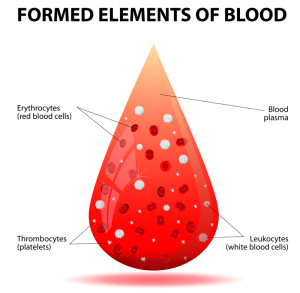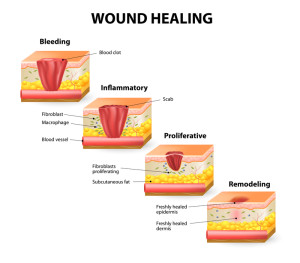Understanding Platelets, Growth Factors and The Role of a Matrix in Wound Repair
I am often asked if there is a simple way to understand the complex biological processes involved in wound repair. Hopefully the following story will provide such an answer and explanation.
If you were to imagine two different scenarios that have the same goal in mind, we might be able to simplify your understanding of how the body repairs itself when an acute injury is present.
Lets imagine that a beautiful resort in a mountainous region was engulfed in flames and was significantly damaged.
The fire also spread to the entrance of the resort and burned a bridge that spanned a very deep and very wide gully. This bridge was the only way in or out of this resort.
In order to get a repair crew on site, the initial problem is how to get a new bridge built in the shortest time possible. The engineers assigned to this task come up with a brilliant idea of forming a temporary scaffold that can be used to get the working crew from one side of the gully to the other, thus allowing the workers to pass across without facing any obstruction.
Once into the job site, the foreman realizes that he is going to need 100 times more men in order to expedite the tear down and rebuilding of this damaged resort. So, he sends out word for more laborers, carpenters, bricklayers, plumbers, painters, electricians and other maintenance men. In addition, he will need food for the men and a power source to run the tools.
Once they have the scaffold secured, the extra workers can run more electrical wire for the extra power that will be needed to handle the massive construction project under way. Because the foreman was astute and asked for more workers, the resort was eventually completed in a record breaking time and is now operating at full capacity.
What Happens in the Human Body
We have a patient who has endured a very nasty injury while falling off of a motorcycle. He has massive soft tissue damage and has broken his femur in two places.
The body’s natural response is to get the coagulation cascade involved to immediately stem the loss of blood. During this process, the platelets are activated and rush to the injured site to be trapped inside of the blood clots where they change their shape in order to cover a greater surface area and plug the holes left after the fibrin has finished its crosshatching.
During this phase, the platelets are also releasing the contents of their alpha and dense granules in an effort to call in the cells needed to initiate the wound repair process. This is a very similar action that was taken by the foreman on the construction site we just talked about.
The scaffold can be compared to the blood clots being formed while the workers in this scenario are various cells that will repair the fractured bone, the damaged tissue and the torn blood vessels. We can bring in 100 times more “workers” by preparing platelet rich plasma.
In this process we can increase the ratio of platelets to plasma and when this product is activated, it sends out a signal that many of the workers have receptors for.
We will have the initial inflammatory phase with the introduction of white blood cells setting up a safety perimeter and carrying away all of the damaged tissue.
Next we have the vascular endothelial cells re-establishing the blood supply (similar to the guys running cable for power) we have the fibroblast cells producing collagen and forming a new extracellular matrix,(similar to the carpenters) we have the osteoblasts entering the picture to initiate the repair of the broken bone, epithelial cells are similar to the “roofers” by climbing up the walls of the wound bed covering the new tissue and we have stems cell that are the workers who are the “jack of all trades” and can do a little bit of everything by being able to change their “hats at will and jump in as needed.
By stimulating the wound repair process with a great number of platelets we have succeeded in closing this wound and healing the patient in a record breaking time and he is now operating at full capacity.
So when you break it down to this simple illustration, our complex biological process involved in wound healing hopefully does not seem quite so difficult to understand.

